

In the face of increasing climate instability, demographic growth and human migrations, and the emergence of new geopolitical centres, which will affect the global economy (including increase of food prices and intensified environmental impact), there is an urgent need to reverse degradation of water resources and stop further decline in biodiversity. Appreciation and optimization of ecosystem services for society along with enhancement of resilience of river basins to climatic and anthropogenic stress may greatly contribute to reach this goal.
In the Anthropocene, most of the global landscape, except deserts, high mountains and the boreal zone, has been converted into agricultural land with spots of highly modified urban areas. This over-engineering of urban and agricultural landscapes results in a reduction of biomass and organic matter, leading to a modification of the water cycle from the model situation where biological component stabilizes the heat budget and water dynamics at the intermediate disturbance level, to a model where the water cycle accelerates and becomes more stochastic and unfavourable for biota and humanity (droughts and catastrophic floods).
Additionally, these processes reduce carbon storage and nutrients transfer from mineral to organic forms, impacting the material cycle. To reverse those negative processes, a two-steps strategy has to be elaborated and implemented. The first proposed step should be based on Von Weizsäcker’s reduction of energy and matter use per GDP. The second proposed step is based on Ecohydrology theory to regulate hydrological and nutrients’ cycles in “novel ecosystems” (agricultural and urban) towards the enhancement of carrying capacity of the global ecosystem. Carrying capacity enhancement is understood as the enhancement related to water resources, biodiversity, ecosystem services for societies and the resilience to increasing various forms of impact.
Since 2011 UNESCO-IHP promotes the establishment of various demonstration sites around the world to apply Ecohydrology solutions in watersheds at all scales. Each demonstration site aims to apply Ecohydrology principles and solutions to solve both social and environmental issues. These solution-oriented projects and methodologies are shown in this web-platform to disseminate the acquired information to UNESCO’s Member States and the general public. This information will allow to apply an Integrated Water Management in other locations.
The demonstration sites and their main characteristics (including related scientific papers, etc.) are synthesized and are available to access through the following list or map visualization.
UNESCO and related organizations are organizing events around the world. Here you will find the links to some of them. For other queries and general questions related to the conferences, including requests for invitation letters, please contact the organizers directly.
The International Conference on Ecohydrology seeks to bring together the international scientific and educational communities to, jointly with the institutional and socio-economic sectors, discuss the existing good practices and the solutions
Date: 2017-03-20 00:00:00.0 Place: Vitoria, Brazil
ACHIEVING THE SDGs ON WATER SECURITY AND SANITATION
Date: 2016-07-18 00:00:00.0 Place: Dar es Salaam, Tanzania
The International Ecohydrology Conference - for security of aquatic systems and societies, was organized in collaboration with UNESCO IHP Programme, UNESCO Water Centres and Long-Term Ecosystem Research Network. It took place in RJ, Brazil
Date: 2017-03-20 00:00:00.0 Place: Campos dos Goytacazes, RJ, Brazil
If you have a long-term engagement with a solution-oriented project that applies a ecohydrological implementation principle, you are welcome to postulate to the Ecohydrology Network. The main benefit of being part of the network is the visibility that the project can get, deploying to a wider audience: more people can know the project. Every year UNESCO-IHP and specifically the Ecohydrology Programme reach several seminars and related events around the world disseminating the Ecohydrology concept and the demonstration sites information. Additional, an intangible good reputation is acquired by projects inside of the network, an additional value regarding founds solicitation.
Application to become a UNESCO Ecohydrology Demonstration site will be done through a two-step on line questionnaire, “demonstration cards” will be constructed through an automatic user friendly process.
First step: provide a main description of the demonstration site that will be submitted to the Scientific Advisory Committee.
Second step: If accepted, you’ll have access to the EH Technical Form, a second and more detailed questionnaire (8 sections).
Know more by clicking on the link below:
Funding opportunities for your Ecohydrology projects are available through crowfunding, grants, and others. Funding opportunity announcements including program announcements, notices of funding availability, solicitations, and funding opportunities with different names will be available depending on the agency and the type of program. The announcements can be found by following the link below and also on the website of the funding agency or program. These links are in constant development, therefore please check constantly for the updates.

The web-platform contains information about the Ecohydrology demonstration sites and their main characteristics (including related scientific papers etc.), major ecohydrology-related events, funding opportunities and a link to apply to the Ecohydrology network. Application to become a UNESCO Ecohydrology Demonstration site can be done through the web platform and “demosite cards” will be constructed through an automatic user-friendly process. The web platform will bring a new, unified-format visualization of the works done separately on each demosite, also playing the role of a shared platform to bring together the related scientific projects and to revitalize the network.
